The Greatest inspiration any kid could hope for… to lose your virginity to Cecil DeMille”
– Steven Spielberg

Few words can describe the monumental Cecil B. DeMille. However, one word is especially appropriate.
Epic.
Paramount Pictures 1956 release of the Academy Award-winning, Cecil B. DeMille-directed epic and international success, ”The Ten Commandments,” is more than likely the most famous religious-drama of all time.
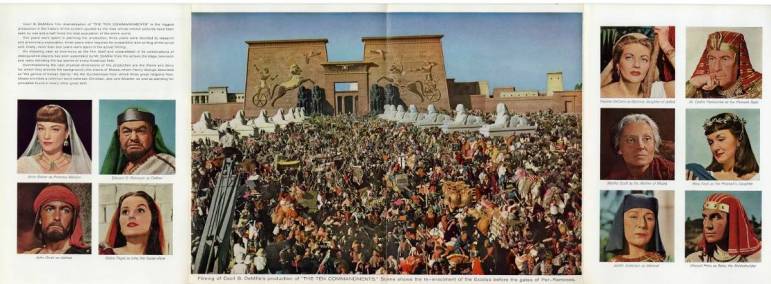
The true definition of a motion picture, its VistaVision filming, use of Technicolor and groundbreaking special effects leave audiences entirely satiated. In its opening, the famous Paramount mountain logo is colored in red and yellow hues, painted to portray Mt. Sinai. Underneath it reads “A Cecil B. Demille Production,” informing us that what we are about to see is clearly a notch above the rest, imperative enough to create a distinctive overlay from the accustomed. It is nontraditional, yet perfectly fitting for the mammoth director.
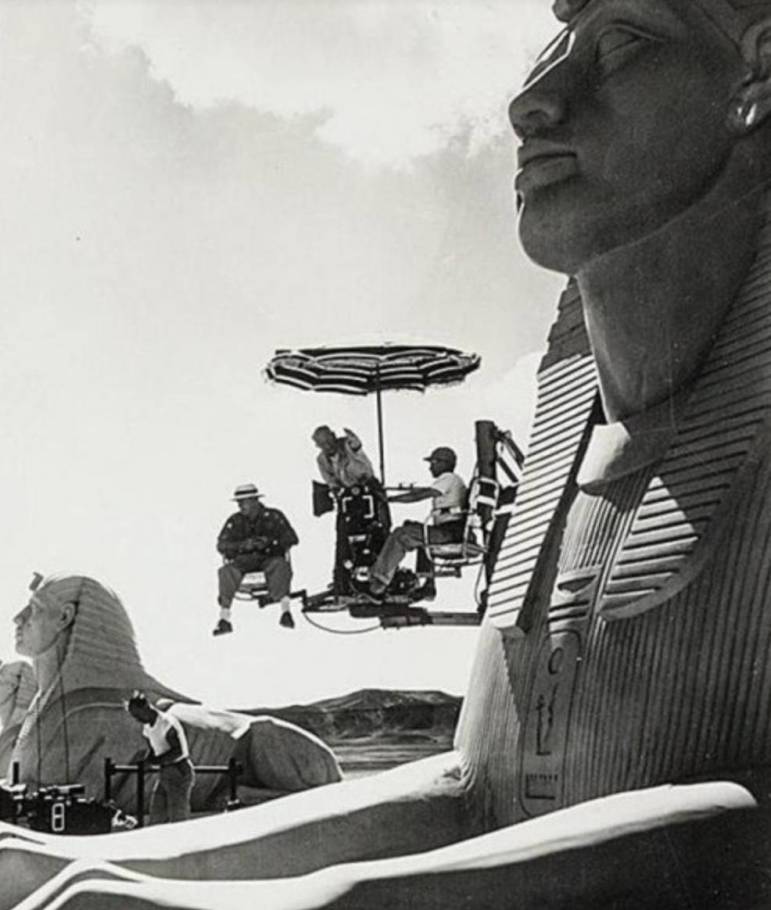
“The Ten Commandment” features an extraordinary who’s-who of bygone Hollywood stars, including Charlton Heston as Moses, Yul Brynner as Pharaoh, Anne Baxter as Neferteri and a host of others.
A summary of the plot follows, written by Ron Kerrigan
To escape the edict of Egypt’s Pharaoh, Rameses I, condemning all newborn Hebrew males to death, the infant Moses is set adrift on the Nile in a reed basket. Saved by the pharaoh’s daughter Bithiah, he is adopted by her and brought up in the court of her brother, Pharaoh Seti. Moses gains Seti’s favor and the love of the throne princess Nefertiri, as well as the hatred of Seti’s son, Rameses. When his Hebrew heritage is revealed, Moses is cast out of Egypt, and makes his way across the desert where he marries, has a son and is commanded by God to return to Egypt to free the Hebrews from slavery. In Egypt, Moses’ fiercest enemy proves to be not Rameses, but someone near to him who can ‘harden his heart’.

Cecil B. Demille, originally from Ashfield, Mass., arrived in Hollywood in 1913. His deified stature is indisputable amongst Hollywood’s elite, hence, the yearly coveted award of his namesake earned by remarkable figures such as Oprah Winfrey, Meryl Streep, Denzel Washington, and Martin Scorsese.

During the 1930s, DeMille became a pop-culture icon as he held an audience of 30 million captive on a weekly basis on The Lux Radio Theatre. Consequently, when he appeared on screen before the beginning of the film, offering a formal introduction, audiences welcomed him. Victor Young who composed the score for DeMille’s 1952 film, “The Greatest Show on Earth,” and also slated to compose the score for “The Ten Commandments,” fell ill and feared he would be unable to complete the assignment. He offered the task to his colleague, composer Elmer Bernstein, who happened to be on the studio lot for a one-week contract, creating incidental music for the film. Bernstein composed a soul-reverberating score that commands you into the film, and it is evident, the experience at hand is going to be an event, not a regular run of the “Mille” picture.
Introduced by the timpani and authoritative brass, the horns follow, the climaxing crashing cymbals, that echo of the seminal parting of the waters to come. You can almost feel the sea mist spray against your skin. Then low big brass re-enters signaling the grandiosity of the film. Strings overlay, and if you listen closely, as with most great orchestrations, the drama about to unfold is indicated beforehand. (Think John Williams and Star Wars.) There is power, love, conflict, intrigue, mystery, sadness and triumph entangled within its instrumentation, evidencing the sign of a remarkable composer.
Paying tribute to the then-dying American tradition of the circus DeMille’s prior film, where he first worked with Heston who played the lead, was “The Greatest Show On Earth.”
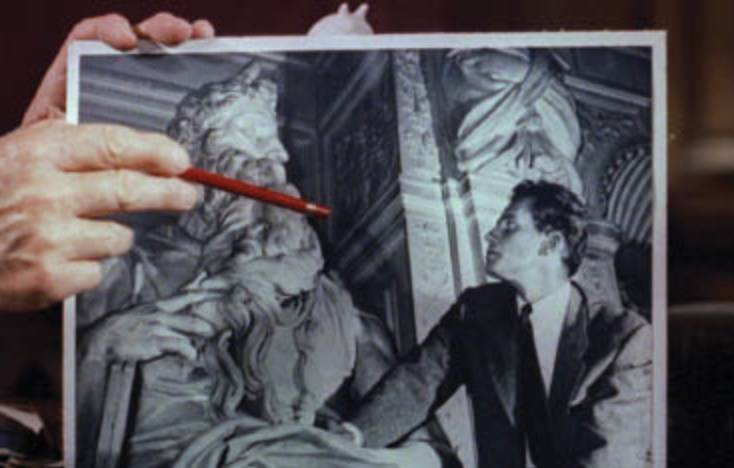
“If you can’t make a career out of a DeMille picture you’re in the wrong business”
-Charlton Heston
After working with Heston, and observing his uncanny resemblance with Michelangelo’s Moses, Heston garnered the coveted role. “The Ten Commandments” amassed international fame, an appropriate pinnacle of DeMille’s over 40-year career. After finding success in the early 1900s DeMille’s movies had been slowly falling out of favor since the early ’30s, a result of his resistance to changing tastes.
Known for spectacle, DeMille definitively found an unbeatable combination in religion, and sexuality that kept his audiences thoroughly entertained. In his 1919 pre-code film, “Male and Female,” with silent era mega-star Gloria Swanson as the lead, best known for her indelible role in Sunset Boulevard (learn more about Sunset here ) Swanson lay face down, with a live lion on her bare back and a lesbian dance sequence led to increased censorship in 1932 in “The Sign Of The Cross” forcing DeMille to tone down his overt innuendo in the sensational 1934 film “Cleopatra.”
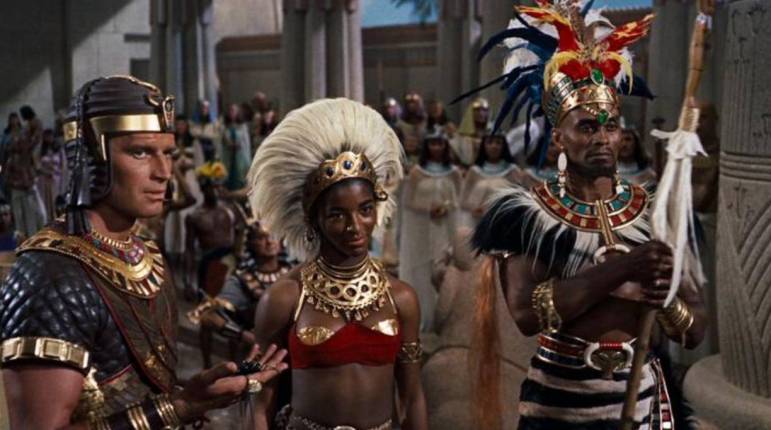
A stickler for accuracy, Demille spent four years in preparation before the cameras began to roll. His films were grandiose, hyper-inflated, included massive sets, elaborate costuming with precise periodic detailing.
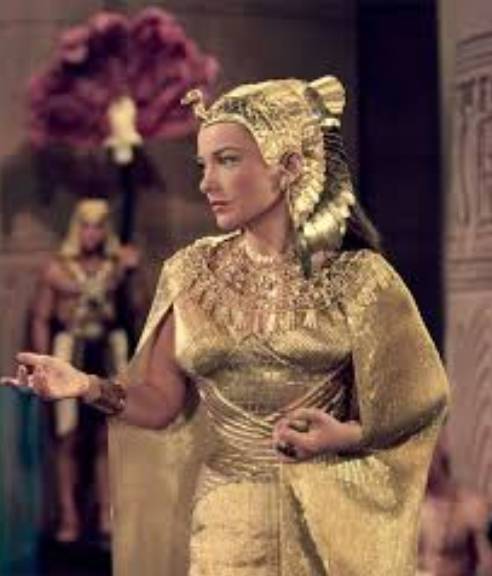
Opinions of DeMille differ. Some say he was a tyrant, others saw him as benevolent. However, one truth resounds, he encompassed an unprecedented level of generosity amongst his staff and crew. He gave all earnings for 1927’s “The King of Kings” to charity and shared 10 percent of his personal earnings between 100 staff members of “The Ten Commandments.” Granting the blacklisted Edward G. Robinson a role within the film, Robinson is quoted as stating “DeMille saved my career.”
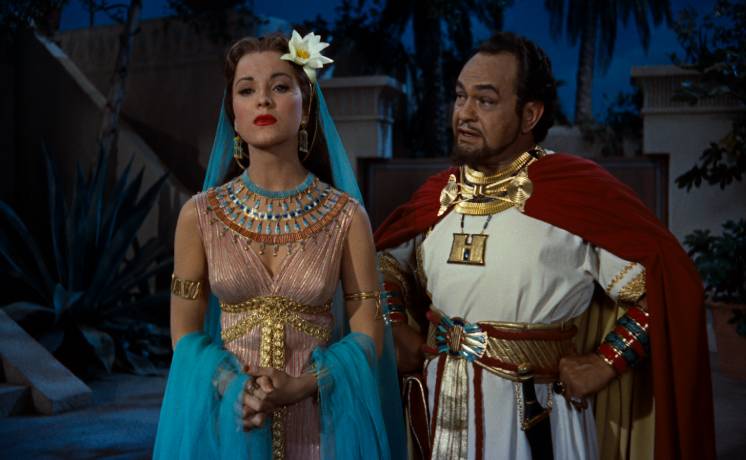
Known for extending employment to “old-timers,” as the Hebrews escape the Egyptians through the parted Red Sea, and old, frail, thin, man is carried by a younger, sturdy man. Unable to walk, he is H.B. Warner and is truly in the twilight of his years. Twenty-nine years prior, he played Christ in DeMille’s silent film “The King of Kings.” Demille, arranged for Warner to be transported by ambulance to the set, and when he was unable to recall his lines, DeMille, confident in his actor’s ability directed him to improvise. When it was time for Warner’s dialogue, with glazed eyes, yet clearly bright with intelligence, he speaks powerful words. ”I am poured out like water … my strength dried up … into the dust … of death.” Warner died in 1958, poetically ending his film career with the same director who gave him his best-known film success.
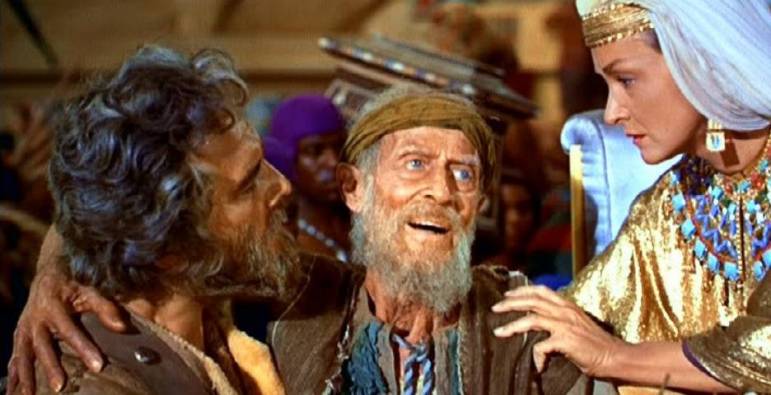
During production, while climbing a 107-foot ladder, for a better perspective, DeMille suffered a massive heart attack. Advised by his doctor to stop filming or else he would die, determined to finish, DeMille answered, “Then I will die.” One week after his heart attack, that he disguised as dysentery, he was back on set.
Fortunately, DeMille’s foresight and meticulous preparation saved him as colleagues rallied, following the pre-made plans, pulling as much pressure off of the director as he would allow. Of course, in such an expansive production anecdotal stories exist — one of which goes like this: DeMille, frustrated with two female extras who were holding a conversation while he was directing, asked both to come forward and divulge the conversation. Reluctantly one of the extras took the mic and stated, “I was just asking my friend, when is that old bald-headed SOB going to call lunch?” After the laughter subsided, unaffected, DeMille gripped the microphone and stated, “Lunch.”

With groundbreaking special effects, “The Ten Commandments” utilized animation, for the burning bush scene, of which Heston was the voice over, the writing of the tablets, burning of hail and the pillar of fire. When Neferteri is watching Ramses army leave, and when Pharoh is overseeing the construction of his city the film is superimposed.
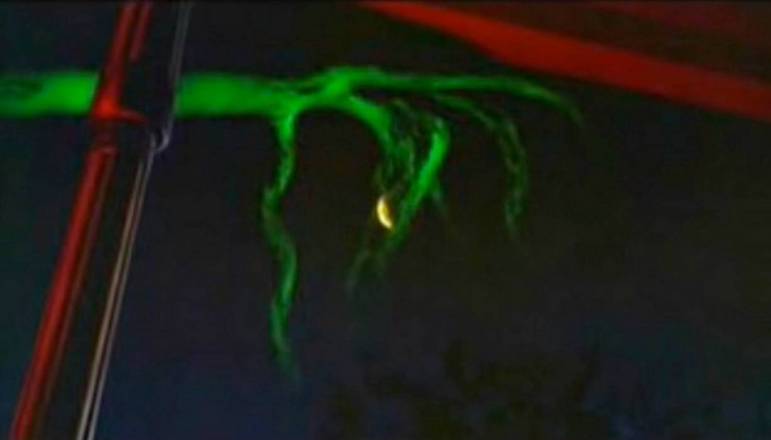
Sure, we can see the translucent outline, but in 1956, where computer animation was non-existent, such effects were ahead of their time. For its grandest feat — the parting of the Red Sea — known as the greatest special effect of all time (recently mimicked in Disney’s animated Moana) the entire Paramount backlot was rebuilt to accommodate immense water tanks for the enactment. It contained tons of gallons of water and a wall was removed between adjoining studios Paramount and RKO, used to create the long passage for the actors to walk through.
See how the special effects were done below:
Film facts
- The 10 Commandments was DeMille’s second remake of the film. His original film was a 1923 release. It was also his last film.
- The massive 1923 set was buried in the sands of California. Documented in the film, “The Lost City” (free on Prime)
- Over 14,000 (some say 20,000) extras and 15,000 livestock (donkeys, camels, cattle, horses) were used, which included a tented city complete with bathing facilities, livestock stations, and a 24-hour kitchen.
- DeMille fired a gun to signal action for scenes, as a bullhorn was ineffective.
- Baby Moses seen at the beginning of the film is Charlton Heston’s real-life son.
- Long shots were conducted on location in Egypt. All other filming took place on the Paramount lot.
- Costumes were a composite of five separate designers, including Edith Head.
- The film cost $13.2 million to make and grossed $93 million.
- Audrey Hepburn was a candidate to play the leading female role of Nefeteri, however, she was passed over because her figure was not that of the classic Egyptian woman.
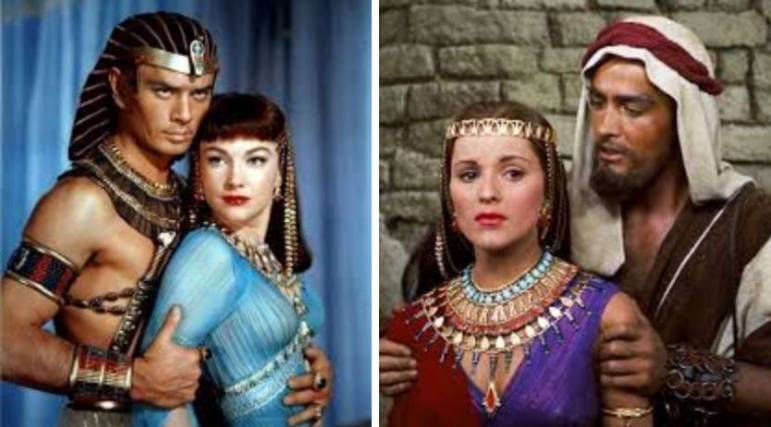
Left, Anne Baxter and Yul Brynner; right, Debra Paget & John Derek.
On Jan 20th, 1959 DeMille wrote a note, “The Lord giveth and the Lord taketh away. Blessed be the name of the Lord. It can only be a short time until those words, the first in the Episcopal funeral service are spoken over me. After those words are spoken what am I? I am only what I have accomplished.”
The following morning, Cecil B, DeMille, film titan, pioneer and purveyor of spectacle died at 77 years old. And what did he accomplish? An unequivocal legacy, an inexpungible impression, dynamically proclaiming to the world in its entirety, his formidable presence.
DeMille truly was here.








